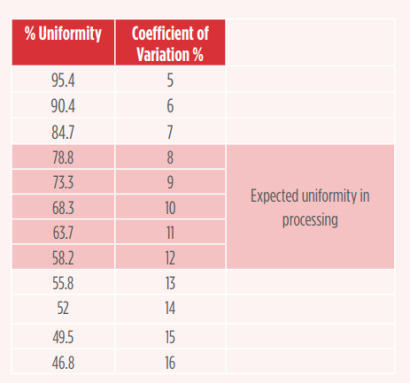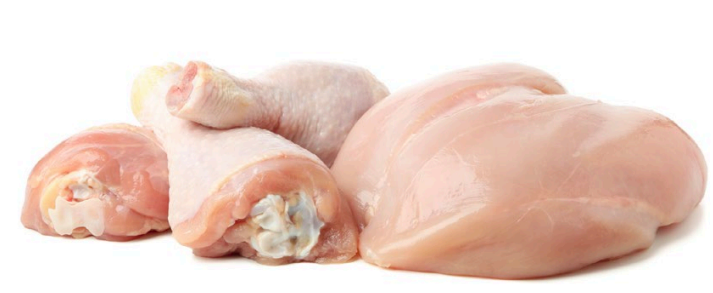Live production has multiple impacts on the outcome of product quality and yield. Factors including bird health, feed withdrawal, catching practices and transportation logistics can directly impact the quality and quantity of yield.
However, good uniformity can impact the quality and quantity of the entire flock being processed.
Poor uniformity will create issues along the processing continuum. Excessive amounts of small birds create difficulty with stunning and bleeding settings. Small birds mixed into a flock create a difficult picking configuration and usually result in carcasses with legs pulled out of shackles and over-picking.
Very large birds have picking issues including under-picking and “riding over” the pickers. Small birds will over-scald compared to larger birds. Additionally, performance of evisceration and automated cut-up and debone equipment suffers and rates of bird damage, rework and product loss increase as uniformity decreases.
In plants that size carcasses before selecting them for further processing lines, small birds will not fit into a value added product line. For this reason, good flock uniformity allows plants to produce more of the higher value products.
MEASURING THE IMPACTS OF UNIFORMITY ON PROCESSING
Standard deviation is a measure of how widely values are dispersed around the average value (the mean). A wide standard of deviation indicates poor uniformity. Therefore, as the standard deviation increases (i.e. uniformity decreases) the coefficient of variation will increase.
[Standard deviation (grams) / Average body weight (grams)] * 100 = Coefficient of variation (CV) %

Table 1. The relationship between uniformity and coefficient of variation.
As seen in table 1, as CV increases, the uniformity decreases. At and below 12% CV, most equipment can accommodate the variation in carcass size. Above 12%, the equipment cannot be adjusted to the sizing extremes (very small and very large) which causes product loss.

The optimal uniformity target will vary for each plant and will depend on the amount of product and product mix being produced and the type of automation the plant is using.
The amount of product lost to uniformity issues with the stunner and scalder will be similar among different plants. However, the value of uniformity increases for plants that have more automated equipment.
Furthermore, uniformity is very important when sized product mixes are being produced.
MEASURING ISSUES RELATED TO UNIFORMITY AND IMPROVEMENTS TO REDUCE THESE PROCESS ISSUES


MONITORING AND MEASURING FLOCK UNIFORMITY
A processing plant cannot correct uniformity issues, but can adjust processing and provide feedback to farms to help correct farm programs and management issues. If uniformity is a consistent issue, the farm program may need to be re-evaluated and corrected.
If uniformity is occasionally an issue, changes in personnel or management may be the cause. To identify and correct ilikeness ssues, uniformity should be monitored regularly.
Two methods for regular monitoring include:
Measuring live bird weight at the receiving dock of the processing plant. In this case, sample 100 birds, but select those 100 birds from multiple containers on the truck.
Collecting and measuring sizes of carcasses in the packaging area can also provide information related to uniformity. However, this measurement is not as accurate as live weight because the impact of processing and chilling varies from bird to bird.
If your operation has issues with uniformity, begin by collecting data at the plant. Measure likeness throughout the process by comparing processing data as described in this article. If issues with uniformity cannot be identified with processing plant data, collecting data and conducting trials at the farm can also be a valuable tool to help correct uniformity.
For more information visit https://www.cobb-vantress.com/
Subscribe now to the poultry technical magazine
AUTHORS

Layer Longevity Starts at Rearing
H&N Technical Team
The Strategy for a Proper Infectious Bronchitis Control
Ceva Technical Team
Elevate Hatchery Performance with Petersime’s New Data-Driven Incubation Support Service
Petersime Technical Team
Maize and Soybean Meal Demand and Supply Situation in Indian Poultry Industry
Ricky Thaper
Production of Formed Injected Smoked Chicken Ham
Leonardo Ortiz Escoto
Antimicrobial Resistance in the Poultry Food Chain and Novel Strategies of Bacterial Control
Edgar O. Oviedo-Rondón
GREG TYLER INTERVIEW
Greg Tyler
Insights from the Inaugural US-RSPE Framework Report
Elena Myhre
Newcastle Disease: Knowing the Virus Better to Make the Best Control Decisions. Part II
Eliana Icochea D’Arrigo
Avian Pathogenic E. coli (APEC): Serotypes and Virulence
Cecilia Rosario Cortés
The Importance of Staff Training on Animal Welfare Issues in Poultry Industry
M. Verónica Jiménez Grez
Rodent Control is a Key Factor in Poultry Biosecurity and Sustainability
Edgar O. Oviedo-Rondón